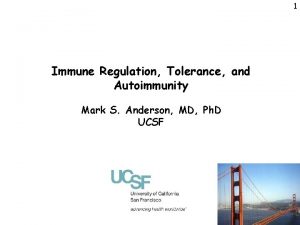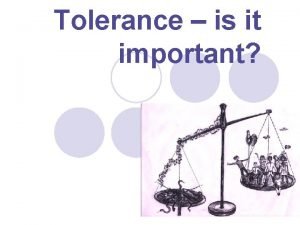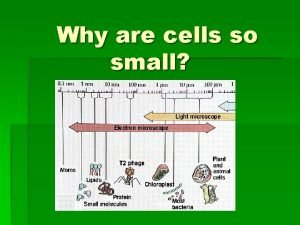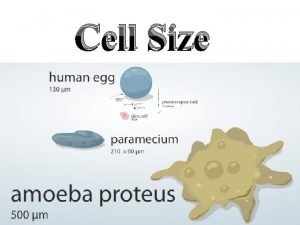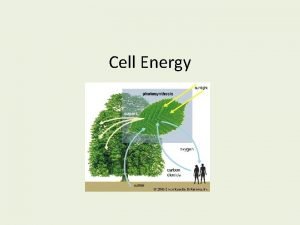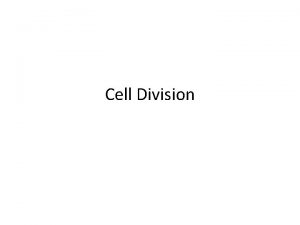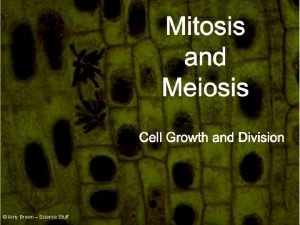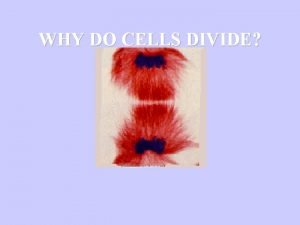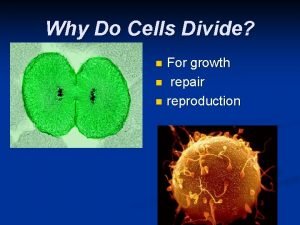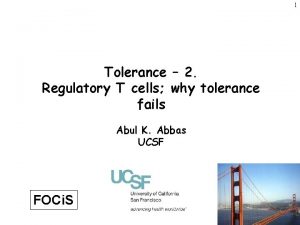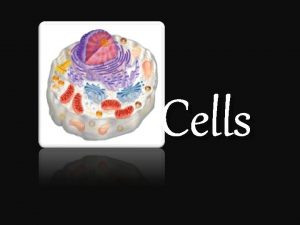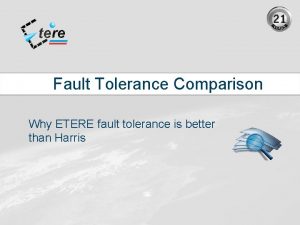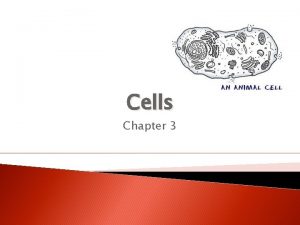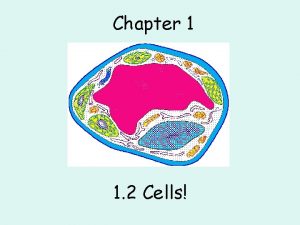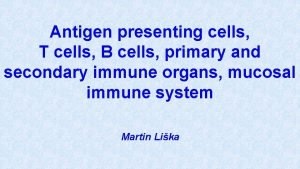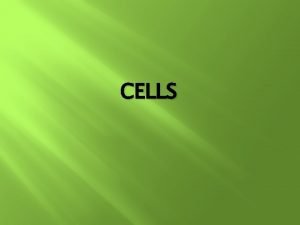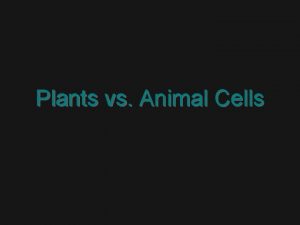1 Tolerance 2 Regulatory T cells why tolerance
































- Slides: 32

1 Tolerance – 2. Regulatory T cells; why tolerance fails Abul K. Abbas UCSF FOCi. S

2 Lecture outline • Regulatory T cells: functions and clinical relevance • Pathogenesis of autoimmunity: why selftolerance fails • Therapeutic approaches for immunological diseases

Regulatory T cells 3

4 Properties of regulatory T cells • Phenotype: CD 4+, high IL-2 receptor (CD 25), low IL-7 receptor, Foxp 3 transcription factor; other markers • Essential features of stable Tregs: – Foxp 3 expression: requires demethylated noncoding CNS 2 sequence in promoter – CD 25 (IL-2 Ra) expression: IL-2 is a necessary survival factor – CTLA-4 expression: required for suppressive function of most Tregs – (Inability to produce IL-2) Take home messages

5 The significance of Foxp 3+ Tregs • Genetic evidence: Foxp 3 mutations --> autoimmune disease (IPEX); in mice, disease can be corrected by providing normal Foxp 3+ cells • Do defects in Foxp 3+ Tregs or resistance to Treg-mediated suppression contribute to common autoimmune diseases? – Inconsistent and variable data

6 Populations of Tregs • Thymic (natural) – Induced by self antigen recognition during T cell maturation • Peripheral (adaptive) – In response to antigen exposure in the periphery; contribution to preventing inflammatory disease? • Induced (in vitro; sometimes called Tr 1) – Culture with TGF + IL-2; therapeutic options • There are no reliable markers for distinguishing these Tregs in a “bulk” population

Mechanisms of action of Foxp 3+ Tregs • CTLA-4 on Tregs removes B 7 on APCs, reduces CD 28 engagement and T cell activation – Genetic deletion of CTLA-4 in Foxp 3+ cells results in severe systemic autoimmunity and lymphoproliferation • Inhibitory cytokines produced by Tregs (TGF- , IL-10, others? ) suppress immune responses (DCs, Macs, T cells) – IL-10 deletion in Foxp 3+ cells results in colitis – IL-10 is also produced by Foxp 3 - cells • Consumption of IL-2 7

8 The balance of effector and regulatory T cells

Role of Tregs in fetal tolerance • In evolution, placentation developed at the same time as the ability to generate Fox. P 3+ peripheral Tregs • Paternal antigens expressed in the fetus induce long-lived antigen-specific Tregs; elimination of these Tregs in mice results in fetal resorption • Anatomic restriction of immune regulation? • Role in humans? Are defects in regulatory memory the basis of recurrent fetal loss? • Did peripheral Tregs evolve to protect the fetus? 9

10 “Non-immune” functions of tissue Tregs • Tregs in adipose tissue regulate lipid metabolism • Tregs in muscle and other tissues produce growth factors that promote repair (trauma, infections, degenerative diseases) • Do Tregs adapt to their environment, or do distinct subsets exist that populate different tissues?

11 Regulatory T cells • Explosion of information about the generation, properties, functions and significance of these cells • Will cellular therapy with ex vivo expanded Treg become a reality? • Therapeutic goal: induction or activation of Treg in immune diseases Take home messages

12 The therapeutic potential of regulatory T lymphocytes • Cell transfer of autologous Tregs to suppress immune responses – Grow up patient’s Tregs ex vivo – Ongoing clinical trials show it is safe, and has some (modest) benefit • Administer antigen or antigen mimic in ways that induce Tregs? – Weak stimulus (peptide antigen, anti-CD 3); + IL-2?

Functions of Interleukin-2: the dogma 13

14 The unexpected biology of IL-2 • Interleukin-2 is the prototypic T cell growth factor (TCGF), required for initiating clonal expansion of T cells in response to antigen • Prediction: what will be the consequence of eliminating IL-2 or the IL-2 receptor?

15 The unexpected biology of IL-2 • Interleukin-2 is the prototypic T cell growth factor (TCGF), required for initiating clonal expansion of T cells in response to antigen • BUT: knockout of IL-2 or the a or chain of the IL-2 R results not in immune deficiency but in systemic autoimmunity and lymphoproliferation

Dual roles of IL-2 in T cell responses 16 Surprising conclusion from knockout mice: the non-redundant function of IL-2 is in controlling immune responses Take home messages

IL-2 dependent activation of regulatory T cells suppresses effector responses Germain lab. Nature 528: 225, 2015 17

18 The role of IL-2 in the lives of regulatory T cells • IL-2 is a survival factor for maintaining Tregs in the periphery – Source of IL-2 is T cells that respond to antigens (microbes, other environmental antigens? ) • IL-2 is also required for the functional competence of Tregs – Promotes Fox. P 3+ CTLA-4+ T cells

19 Therapeutic potential of IL-2: a revision • IL-2 was originally used to boost immune responses in cancer, HIV infection (promoting effector and memory T cells) • Inconsistent clinical results

20 Therapeutic potential of IL-2: a revision • IL-2 was originally used to boost immune responses in cancer, HIV infection • IL-2 treatment can increase number and functional activity of Tregs • Low-dose IL-2 to treat steroid-resistant chronic GVHD, vasculitis • More recent clinical trials ongoing in type 1 diabetes, SLE, graft rejection

21 Therapeutic potential of IL-2: a revision • IL-2 was originally used to boost immune responses in cancer, HIV infection • IL-2 treatment can increase number and functional activity of Tregs • The challenge: IL-2 activates both effector and regulatory T cells • Low-dose IL-2 acts preferentially on Foxp 3+ Tregs • Mutant forms of IL-2 that preferentially activate Tregs • IL-2 -antibody complexes that target cytokine preferentially to IL-2 Ra or IL-2 R Take home messages

22 Role of dendritic cells in selftolerance • Mature DCs (activated during innate immune responses to PAMPs and DAMPs) express costimulators, secrete cytokines, and initiate immune responses • Immature (“resting”) DCs live in tissues, display self antigens and maintain tolerance (by inducing anergy, deletion, and/or Tregs) Take home messages

23 The potential of “tolerogenic antigenpresenting cells” • Exploiting antigen-pulsed DCs to induce tolerance – Phase 1 trial of DCs pulsed with citrullinated peptides in RA published in 2015 – Maintaining DCs in tolerogenic state? • Can DCs be modified to make them tolerogenic? – Expression of costimulator antagonists, immunosuppressive cytokines, other inhibitors: being tried in animal models of graft rejection

Regulating immune responses: where are we? • Elucidating the mechanisms of immune regulation is one of the dominant themes of modern Immunology; obvious relevance to immune-mediated inflammatory diseases, therapeutics, vaccines • Already leading to new therapeutic strategies • Continuing challenge is to establish the importance of control mechanisms in the development of inflammatory diseases 24

Autoimmunity • Definition: immune response against self (auto-) antigen, by implication pathologic • Much of our knowledge of immunological disorders is based on mouse models • Elucidating the causes of these diseases has been a challenge • Initiating triggers generally unknown • Complex interactions between genes and environment • Unclear which mechanisms of tolerance fail in any disease 25

Pathogenesis of autoimmunity 26

Genetic basis of autoimmunity • Multiple genes are associated with autoimmunity – Most human autoimmune diseases are multigenic – Single gene defects reveal pathways of selftolerance and why it fails (e. g. AIRE, Fas, Foxp 3, many others) but are not involved in most, common autoimmune diseases • Genes include HLA, many others – Each gene individually makes a small contribution – Little predictive value 27

Genetics of autoimmunity: challenges • Relating complex genotypes to phenotypic and functional abnormalities, to better understand pathogenesis – Complex interactions between genes and environment, often difficult to define • Predictive value of genetic polymorphisms – Unlikely because of low odds ratios • Using polymorphisms to identify therapeutic targets – Difficult because any one gene makes a small contribution 28

29 Infections and autoimmunity • Infections trigger autoimmune reactions – Clinical prodromes, animal models – IBD is dependent on gut commensals • Some autoimmune diseases are prevented by infections (type 1 diabetes, multiple sclerosis, others? -- increasing incidence in developed countries): mechanism unknown – The “hygiene hypothesis” • The role of the microbiome?

Therapy of immune disorders: rational approaches target 30 lymphocyte activation and subsequent inflammation

Molecularly targeted therapies for immunological diseases: the rational approach • Target the molecular basis of lymphocyte activation and effector functions: rationally designed therapies – Based on understanding of lymphocyte biology – Risks -- reactivation of infections • Induce antigen-specific immunological tolerance: requires identification of target antigens – Being tried in MS, type 1 diabetes (in which the major autoantigens are known) – Based on successes in allergic diseases 31

Autoimmune diseases • Experimental models are revealing pathways of immune regulation • But experimental animals are often inadequate models of human diseases • Improving technologies for human genetic and phenotypic analyses are enabling studies of patients • Challenges: – Defining which mechanisms of immune tolerance fail in different autoimmune diseases – Using this knowledge to develop therapies Take home messages 32
 Why did robert hooke name cells “cells”?
Why did robert hooke name cells “cells”? Andreas carlsson bye bye bye
Andreas carlsson bye bye bye Unilateral tolerance and bilateral tolerance
Unilateral tolerance and bilateral tolerance Central tolerance and peripheral tolerance
Central tolerance and peripheral tolerance Sphenoid paranasal sinus
Sphenoid paranasal sinus Alpha intercalated cell
Alpha intercalated cell Pineal gland
Pineal gland Gametes vs somatic cells
Gametes vs somatic cells Somatic cells vs germ cells
Somatic cells vs germ cells Chlorocruorin
Chlorocruorin Eukarya
Eukarya Plant and animal cells venn diagram
Plant and animal cells venn diagram Prokaryotic cells vs eukaryotic cells venn diagram
Prokaryotic cells vs eukaryotic cells venn diagram Masses of cells form and steal nutrients from healthy cells
Masses of cells form and steal nutrients from healthy cells Younger cells cuboidal older cells flattened
Younger cells cuboidal older cells flattened Cuál es la diferencia entre la célula animal y vegetal
Cuál es la diferencia entre la célula animal y vegetal Which organisms are prokaryotes
Which organisms are prokaryotes Chapter 8 cellular reproduction cells from cells
Chapter 8 cellular reproduction cells from cells Cells cells they're made of organelles meme
Cells cells they're made of organelles meme Dont ask why why why
Dont ask why why why Why is tolerance important
Why is tolerance important Why are cells small
Why are cells small Why do cells lyse in a hypotonic solution
Why do cells lyse in a hypotonic solution Small cell size
Small cell size Why does a cell need energy
Why does a cell need energy 3 reasons why cells divide
3 reasons why cells divide Why do cells divide? *
Why do cells divide? * Root pressure animation
Root pressure animation Why do cells divide, instead of simply growing larger?
Why do cells divide, instead of simply growing larger? Seedless vascular
Seedless vascular Why do cells need oxygen?
Why do cells need oxygen? Why do cells divide? *
Why do cells divide? * Why do cells divide? *
Why do cells divide? *



